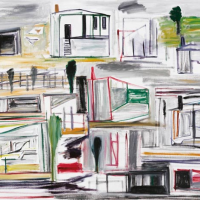28. KEN WHISSON

In the world of art, the waves of style and fashion roll in without cease. Some will be large and powerful, sweeping all before them, but others will be shallow and with little substance. The creative and the enthusiastic will leap on board quickly, perhaps even slightly ahead of the wave, the rebels and the precursors who will lead the way. Most will jump in once they have sniffed the wind and brought their eye to the main chance. Some of these waves will be profound and epoch-making impressionism, cubism and abstract expressionism, while others will be small blips on the cultural landscape, the minor enthusiasms for a particular form, colour or texture. Just like shoulder pads, big hair or flares, they will come and go after their brief time in the sun. But there are artists who choose to swim against the inexorable tide, to steadfastly refuse to participate in the next big thing. Ken Whisson is an exemplar of that non-conformist breed, an artist who has survived, indeed thrived, in taking his own iconoclastic view of the world.
Whisson was born in Lilydale, in Melbournes outer east, now the buffer between suburbia and the fashionable Yarra Valley. In 1927 when the artist was born, it was a small rural town, a railway junction and home to a huge limestone quarry. He had the good fortune to be able to attend Koornong, the new alternative school just over the hills in Warrandyte. There he came under the influence of the eccentric Cossack Danila Vassilieff (1897-1958) who, through his paintings and vigorous conversations, was influencing a whole new generation of young Australian artists, most notably Sidney Nolan (1917-1992) and Albert Tucker (1914-1999). After Whisson had left school, he continued classes with Vassilieff, whose uninhibited expressionism and belief in a child-like lack of sophistication struck a chord with the young artist. He grasped the idea that art should be free of constraint, unfettered by a search for technical perfection or even proficiency to allow the inner person to speak clearly and unhindered by the expectations and limitations of a conservative society.
Whisson did not rush into the life of the exhibiting artist, but rather worked around the edges, testing his ideas and quietly seeking his own truths. It was perhaps easier to see what he didnt want, rather than what he was hoping to express. He stood against an art that sought fame and success, the trappings of wealth and the treadmill of ever-increasing production and prices. Vassilieff had certainly been an appropriate role model, perpetually broke, unwilling or unable to produce saleable works and content to live under straitened circumstances. Through Vassilieff, Whisson drifted into the orbit of John and Sunday Reed and the magnet of the Heide circle. His work was appropriately expressive and experimental in that milieu and he found a particular resonance in the drawings and paintings of Joy Hester (1920-1960).
By the later 1960s, Whisson had begun to find his own voice and he developed a series of motifs and brush strokes that were almost perversely crude in their form and application. He steadfastly shied away from displays of skill and created subjects that were banal in their ordinariness. Suburban streets dotted with parked cars, ramshackle farms and factories, animals, figures and still life compositions were strewn across his canvases as though abandoned by a mob of playful children. His colour could be crude and the paint application wilful, yet the overall effect is arresting and in a strange way compelling. We might wince at his distortions, the tortured figures and the wrecked cars, but we can never pass these works unmoved. Green and Red Farmhouse Painting is classic Whisson, whimsical and erratic with a smatter of sheds and cottages covering the canvas. Many artists had worked around Lilydale between the wars, including Sir Arthur Streeton (1867-1943) and his myriad followers, but Whisson would have none of their blue and gold splendour, depicting instead the ratty chook sheds and handmade houses that marked the area during the depression years of his childhood.
Gavin Fry BA (Hons), MA, M.Phil